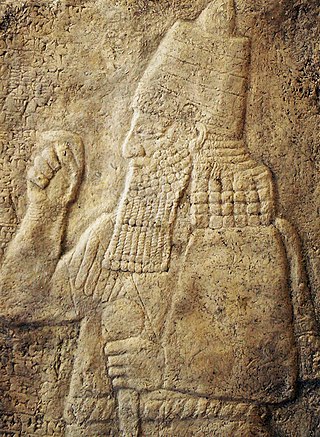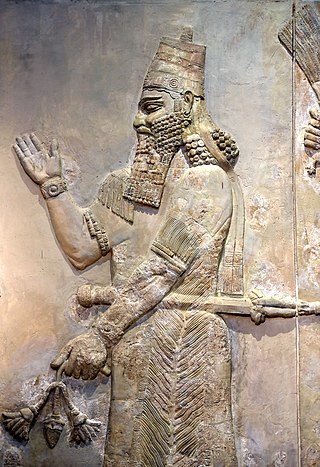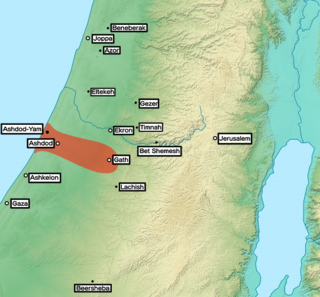Related Research Articles

Sennacherib was the king of the Neo-Assyrian Empire from the death of his father Sargon II in 705 BC to his own death in 681 BC. The second king of the Sargonid dynasty, Sennacherib is one of the most famous Assyrian kings for the role he plays in the Hebrew Bible, which describes his campaign in the Levant. Other events of his reign include his destruction of the city of Babylon in 689 BC and his renovation and expansion of the last great Assyrian capital, Nineveh.

Sargon II was the king of the Neo-Assyrian Empire from 722 BC to his death in battle in 705. Probably the son of Tiglath-Pileser III, Sargon is generally believed to have become king after overthrowing Shalmaneser V, probably his brother. He is typically considered the founder of a new dynastic line, the Sargonid dynasty.

Hoshea was the nineteenth and last king of the northern Kingdom of Israel and son of Elah. William F. Albright dated his reign to 732–721 BCE, while E. R. Thiele offered the dates 732–723 BCE.

The Assyriansiege of Jerusalem was an aborted siege of Jerusalem, then capital of the Kingdom of Judah, carried out by Sennacherib, king of the Neo-Assyrian Empire. The siege concluded Sennacharib's campaign in the Levant, in which he attacked the fortified cities and devastated the countryside of Judah in a campaign of subjugation. Sennacherib besieged Jerusalem, but did not capture it.

Hattusili I was a king of the Hittite Old Kingdom. He reigned ca. 1650–1620 BC, or ca. 1640–1610 BC(low middle chronology). Excavations in Zincirli Höyük, Southern Turkey, suggest that a complex there was destroyed in the mid to late 17th century BC, possibly by Hattusili I in a military campaign, which could confirm the middle chronology dating for his reign. This destruction was recently radiocarbon-dated to sometime between 1632 and 1610 BC. This event could have been part of Ḫattušili's campaign against Zalpa in order to disrupt an exchange network connected to Aleppo that previously linked the Euphrates, North Syria, and Central Anatolia. Aslihan K. Yener dates destruction of Level VII Palace at nearby Alalakh, located around 100 km southeast of Tilmen Höyük, in the second year of Hattusili's reign, 1628 BC.

Yahu-Bihdi also called Ilu-Bihdi was a governor of Hamath appointed by the Assyrian government. He declared himself king of Hamath in 720 BC and led a revolt which was promptly suppressed. Yahu-Bihdi himself was flayed alive. His revolt occurred roughly shortly after the conquest of the Kingdom of Israel by Sargon II and roughly simultaneously with revolts in Babylon as well as in Arpad, Damascus and elsewhere in the Levant.

During the Middle Assyrian Empire and the Neo-Assyrian Empire, Phoenicia, what is today known as Lebanon and coastal Syria, came under Assyrian rule on several occasions.
Sennacherib's Annals are the annals of the Assyrian king Sennacherib. They are found inscribed on a number of artifacts, and the final versions were found in three clay prisms inscribed with the same text: the Taylor Prism is in the British Museum, the Oriental Institute Prism in the Oriental Institute of Chicago, and the Jerusalem Prism is in the Israel Museum in Jerusalem.

The Assyrian captivity, also called the Assyrian exile, is the period in the history of ancient Israel and Judah during which several thousand Israelites from the Kingdom of Israel were dispossessed and forcibly relocated by the Neo-Assyrian Empire. One of many instances attesting Assyrian resettlement policy, this mass deportation of the Israelite nation began immediately after the Assyrian conquest of Israel, which was overseen by the Assyrian kings Tiglath-Pileser III and Shalmaneser V. The later Assyrian kings Sargon II and Sennacherib also managed to subjugate the Israelites in the neighbouring Kingdom of Judah following the Assyrian siege of Jerusalem in 701 BCE, but were unable to annex their territory outright. The Assyrian captivity's victims are known as the Ten Lost Tribes, and Judah was left as the sole Israelite kingdom until the Babylonian siege of Jerusalem in 587 BCE, which resulted in the Babylonian captivity of the Jewish people. Not all of Israel's populace was deported by the Assyrians; those who were not expelled from the former kingdom's territory eventually became known as the Samaritan people.
Purushanda was an Anatolian kingdom of the early second millennium prior to the common era. It was conquered by the Hittites sometime between 1650 and 1556 BCE.
Sargon II's Prisms are two Assyrian tablet inscriptions describing Sargon II's campaigns, discovered in Nineveh in the Library of Ashurbanipal. The Prisms today are in the British Museum.

The timeline of ancient Assyria can be broken down into three main eras: the Old Assyrian period, Middle Assyrian Empire, and Neo-Assyrian Empire. Modern scholars typically also recognize an Early period preceding the Old Assyrian period and a post-imperial period succeeding the Neo-Assyrian period.
Isaiah 20 is the twentieth chapter of the Book of Isaiah in the Hebrew Bible or the Old Testament of the Christian Bible. This book contains the prophecies attributed to the prophet Isaiah.

2 Kings 18 is the eighteenth chapter of the second part of the Books of Kings in the Hebrew Bible or the Second Book of Kings in the Old Testament of the Christian Bible. The book is a compilation of various annals recording the acts of the kings of Israel and Judah by a Deuteronomic compiler in the seventh century BCE, with a supplement added in the sixth century BCE. This chapter records the events during the reign of Hezekiah, the king of Judah, a part of the section comprising 2 Kings 18:1 to 20:21, with a parallel version in Isaiah 36–39.

Sennacherib's campaign in the Levant in 701 BCE was a military campaign undertaken by the Neo-Assyrian Empire to bring the region back under control following a rebellion against Assyrian rule in 705 BCE. After the death of Sargon II, Sennacherib’s father, a number of states in the Levant renounced their allegiance to Assyria. The rebellion involved several small states: Sidon and Ashkelon and Byblos, Ashdod, Ammon, Moab, and Edom who then submitted to the payment of tribute to Assyria. Most notably, Hezekiah of Judah, encouraged by Egypt, joined the rebellion and was subsequently invaded by the Assyrians who captured most of the cities and towns in the region. Hezekiah was trapped in Jerusalem by an Assyrian army and the surrounding lands were given to Assyrian vassals in Ekron, Gaza, and Ashdod, however, the city was not taken and Hezekiah was allowed to remain on his throne as an Assyrian vassal after paying a large tribute. The events of the campaign in Judah are famously related in the Bible which culminate in an “angel of the Lord” striking down 185,000 Assyrians outside the gates of Jerusalem prompting Sennacherib’s return to Nineveh.

2 Kings 17 is the seventeenth chapter of the second part of the Books of Kings in the Hebrew Bible or the Second Book of Kings in the Old Testament of the Christian Bible. The book is a compilation of various annals recording the acts of the kings of Israel and Judah by a Deuteronomic compiler in the seventh century BCE, with a supplement added in the sixth century BCE. This chapter records the events during the reigns of Hoshea the last king of Israel, the capture of Samaria and the deportation of the northern kingdom population by the Assyrians.

Hanunu, sometimes called Hanno, was the Philistine king of Gaza during the 8th century BC. During Hanunu's reign, much of the Levant, including Philistia, was controlled by the Neo-Assyrian Empire.

Iamani or Iadna was a Philistine king of Ashdod during the reign of Neo-Assyrian emperor Sargon II. His names, meaning "Ionian" and "Cypriot", seemingly indicate he was of Greek extraction, and therefore a foreigner amongst the Philistines, although the names themselves are Semitic.

Sargon II ruled the Neo-Assyrian Empire from 722 to 705 BC as one of its most successful kings. In his final military campaign, Sargon was killed in battle in the south-eastern Anatolian region Tabal and the Assyrian army was unable to retrieve his body, which meant that he could not undergo the traditional royal Assyrian burial. In ancient Mesopotamia, not being buried was believed to condemn the dead to becoming a hungry and restless ghost for eternity. As a result, the Assyrians believed that Sargon must have committed some grave sin in order to suffer this fate. His son and successor Sennacherib, convinced of Sargon's sin, consequently spent much effort to distance himself from his father and to rid the empire from his work and imagery. Sennacherib's efforts led to Sargon only rarely being mentioned in later texts. When modern Assyriology took form in Western Europe in the 18th century, historians mainly followed the writings of classical Greco-Roman authors and the descriptions of Assyria in the Hebrew Bible for information. Given that Sargon is barely mentioned in either, he was consequently forgotten, the then prevalent historical reconstructions placing Sennacherib as the direct successor of Sargon's predecessor Shalmaneser V and identifying Sargon as an alternate name for one of the more well-known kings.
Samerina was the province of the Neo-Assyrian Empire established following the c. 722 BCE Assyrian conquest of Samaria by Shalmaneser V, which resulted in the dissolution of the Kingdom of Israel and annexation of Samaria into the empire as a full imperial province administered by a governor.
References
- ↑ "Sargon II Cylinder" (PDF). museum.imj.org.
- 1 2 3 4 5 Matthews, Victor Harold; Benjamin, Don C. (2006). Old Testament parallels: laws and stories from the ancient Near East. Paulist Press. pp. 185–188. ISBN 9780809144358.
- ↑ Olmstead 1931.
- ↑ Israel Ephʻal, The Ancient Arabs: Nomads on the Borders of the Fertile Crescent, 9th–5th Centuries B.C. (Magnes Press, 1982), p. 105.